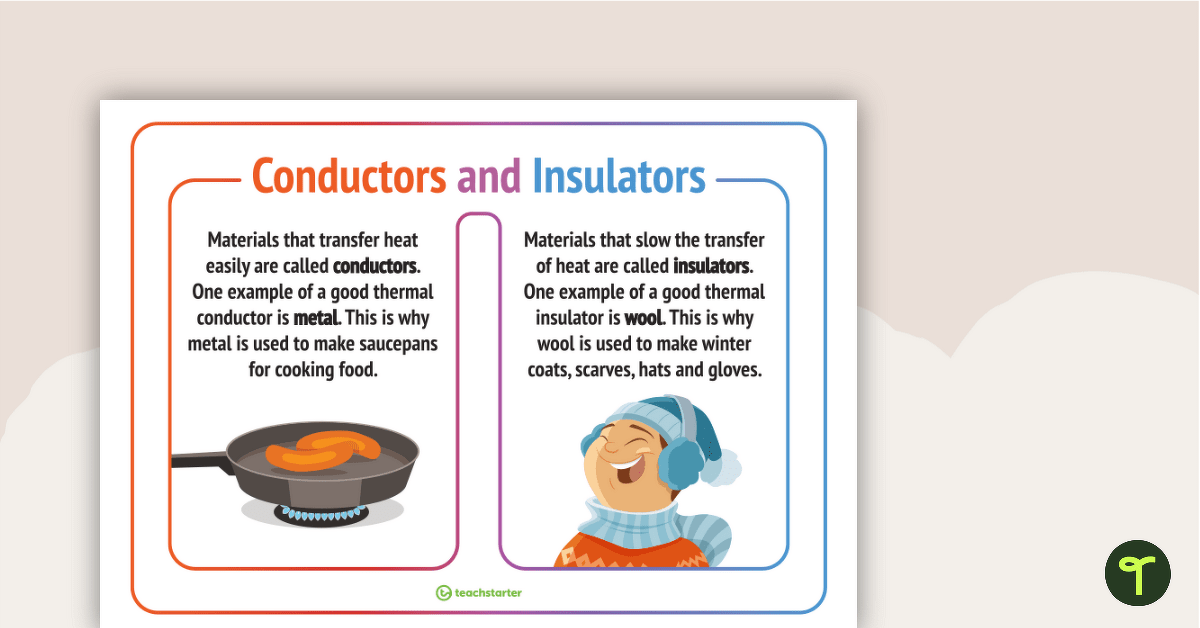One of the major difference between the conductor and insulator is that the conductor allows the energy (i.e., current or heat ) to pass through it, whereas the insulator does not allow the energy to pass through it. Some other differences between them are explained below in the form of the comparison chart. Content: Conductor V/s Insulator
Conductors And Insulators Worksheet | Insulation, Insulators and conductors, Science printables
Nov 21, 2023Activities What are 5 good conductors? Conductors are a type of material used to allow electric flow to move freely. Five examples of conductors include copper, gold, steel, salt water, and

Source Image: youtube.com
Download Image
A conductor is a substance which anticipates free flow of electrical charge. On the contrary, an insulator resists electricity, which means it has exactly the opposite effect on the flow of electrons. The electrons bind together tightly within atoms, thereby restricting free flow of electrical charge.

Source Image: teachstarter.com
Download Image
Conductors and insulators – 65 photo The conducting wires allow electrons to move freely through the cables, which are shielded by rubber and plastic. These materials act as insulators that don’t allow electric charge to escape outward. (credit: Evan-Amos, Wikimedia Commons) Other substances, such as glass, do not allow charges to move through them. These are called insulators.

Source Image: electricalampere.com
Download Image
Insulators Are Different Than Conductors In That Insulators
The conducting wires allow electrons to move freely through the cables, which are shielded by rubber and plastic. These materials act as insulators that don’t allow electric charge to escape outward. (credit: Evan-Amos, Wikimedia Commons) Other substances, such as glass, do not allow charges to move through them. These are called insulators. Updated on November 24, 2019 What makes a material a conductor or an insulator? Simply put, electrical conductors are materials that conduct electricity and insulators are materials that do not. Whether a substance conducts electricity is determined by how easily electrons move through it.
Conductors and Insulators – Examples, Definition
This is a list of 10 examples of materials that are electrical conductors and insulators and a look at why some materials conduct better than others. Pinterest Explore Electricity Conductors or Insulators Cut and Paste Sorting and Matching Activity | Teaching science, Science electricity, Science lessons

Source Image: pinterest.com
Download Image
My First Lab Report | Spyderwolf’s Galaxy This is a list of 10 examples of materials that are electrical conductors and insulators and a look at why some materials conduct better than others. Pinterest Explore

Source Image: spyderwolf.wordpress.com
Download Image
Conductors And Insulators Worksheet | Insulation, Insulators and conductors, Science printables One of the major difference between the conductor and insulator is that the conductor allows the energy (i.e., current or heat ) to pass through it, whereas the insulator does not allow the energy to pass through it. Some other differences between them are explained below in the form of the comparison chart. Content: Conductor V/s Insulator

Source Image: pinterest.com
Download Image
Conductors and insulators – 65 photo A conductor is a substance which anticipates free flow of electrical charge. On the contrary, an insulator resists electricity, which means it has exactly the opposite effect on the flow of electrons. The electrons bind together tightly within atoms, thereby restricting free flow of electrical charge.

Source Image: en.idei.club
Download Image
2,188 Pin Insulators Images, Stock Photos, 3D objects, & Vectors | Shutterstock Different materials will respond differently when charged or exposed to the presence of a nearby charged. All materials are generally placed into two categories – those that are conductors and those that are insulators. Conductors are types of materials that allow electrons to flow freely across their surfaces. Insulators do not allow for the free flow of electrons across their surface.

Source Image: shutterstock.com
Download Image
10 Conductors and Insulators ideas | conductors, 5th grade science, science electricity The conducting wires allow electrons to move freely through the cables, which are shielded by rubber and plastic. These materials act as insulators that don’t allow electric charge to escape outward. (credit: Evan-Amos, Wikimedia Commons) Other substances, such as glass, do not allow charges to move through them. These are called insulators.

Source Image: pinterest.com
Download Image
Electricity – electrons, insulators and conductors — Science Learning Hub Updated on November 24, 2019 What makes a material a conductor or an insulator? Simply put, electrical conductors are materials that conduct electricity and insulators are materials that do not. Whether a substance conducts electricity is determined by how easily electrons move through it.

Source Image: sciencelearn.org.nz
Download Image
My First Lab Report | Spyderwolf’s Galaxy
Electricity – electrons, insulators and conductors — Science Learning Hub Nov 21, 2023Activities What are 5 good conductors? Conductors are a type of material used to allow electric flow to move freely. Five examples of conductors include copper, gold, steel, salt water, and
Conductors and insulators – 65 photo 10 Conductors and Insulators ideas | conductors, 5th grade science, science electricity Different materials will respond differently when charged or exposed to the presence of a nearby charged. All materials are generally placed into two categories – those that are conductors and those that are insulators. Conductors are types of materials that allow electrons to flow freely across their surfaces. Insulators do not allow for the free flow of electrons across their surface.